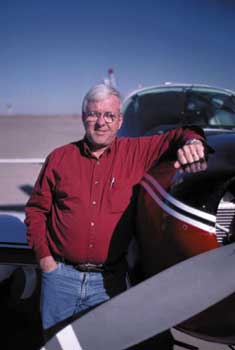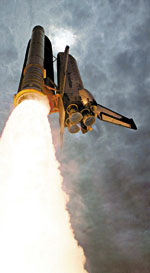|
|

| Wischful Thinking |
| Shuttle Columbia |

by Jay Wischkaemper
Perhaps other space shuttles have passed over Lubbock on their way to a landing in Florida, but if they have, it never made the news. This time however, the local media had been announcing the flyover for several days. Part of the interest was due to the fact that Shuttle commander Rick Husbands had graduated from Texas Tech, and pilot William McCool had graduated from Coronado High School. This was a Lubbock flight.
At about 6:45 a.m., Dianna suggested we get out of bed so that we could be ready to see the shuttle fly over. We walked outside at about 7:50. The schedule called for the shuttle to be visible over Lubbock between 7:56 and 8:00 a.m. At 7:57, we spotted it. A bright point of light streaking across the sky. It was traveling incredibly fast. In less than a minute, it was gone. We went back inside, awed by the experience, and grateful to have witnessed such an impressive sight. About three minutes later, we heard a loud boom. We had wondered whether or not there would be a sonic boom when it went over. We assumed that because of the altitude, the boom took that long to reach the ground and thought nothing of it.
About 15 minutes later, while sitting at my computer, an email came from CNN. Breaking News. Mission control had lost contact with the shuttle. At 7:57, we had watched the shuttle containing seven astronauts fly 44 miles overhead. Five minutes later, they were all dead.
A tragedy like this reminds us of the dangers of any kind of flight, and especially space flight. We can talk all we want to about the fact that the people who do this understand the risk and willingly assume it, but that still doesn’t change the fact that if we measure the safety of space flight by fatalities per flight hour, the record is abysmal. If general aviation had a safety record as bad as space flight, thousands per year would die. Yet, there is still a long list of those wanting to be a part of the astronaut corps. Are they oblivious to the danger? Hardly. They are consumed by the passion of flight.
As I was trying to make sense of what had just happened, my eyes were drawn to a plaque that hangs on my wall. It is a copy of the poem “High Flight,” by John Magee. Listen to the words again.
 Oh, I have slipped the surly bonds of earth Oh, I have slipped the surly bonds of earth
And danced the skies on laughter silvered wings;
Sunward I’ve climbed, and joined the tumbling mirth
Of sun-split clouds—and done a hundred things
You have not dreamed of—wheeled and soared and swung
High in the sunlit silence. Hov’ring there,
I’ve chased the shouting wind along, and flung
My eager craft through footless halls of air,
Up, up the long, delirious, burning blue
I’ve topped the windswept heights with easy grace
Where never lark, or even eagle flew.
And, while with silent, lifting mind I’ve trod
The high untrespassed sanctity of space
Put out my hand, and touched the face of God
Most people lack the ability to understand the emotions expressed by Magee. You don’t feel those things sitting in an airline seat. No one who has not experienced the freedom and beauty and exhilaration of controlling an aircraft could possibly understand what it is that would make someone want to take the risks associated with flight of any kind. In a way, it doesn’t make sense, but flying is at least as much about emotion as it is about logic, and emotion always ignores reality. Every time we crawl in our planes and advance the throttle at the end of the runway, we have the potential of placing ourselves in situations that might find us in a predicament equal to that of those astronauts. Do we worry about it? If we did, we wouldn’t fly. We understand there is danger in anything we do, and while not oblivious to it, the emotions of flight overrule the logic that controls the fearful.
The reason they accepted the risk was stated well by Kalpana Chawla, one of the Columbia crew. “Just looking at earth, looking at the stars during the night part of earth; just looking at our planet roll by and the speed at which it goes by and the awe that it inspires; just so many such good thoughts come to your mind when you see all that,” she said. “Doing it again is like living a dream — a good dream — once again.” Dr. Laurel Clark said, “There’s a lot of different things that we do during life that could potentially harm us and I choose not to stop doing those things.” Rick Husband commented, “It was the achievement of a lifelong dream and a goal. It’s very humbling, I’d say, and exciting at the same time, to be able to actually go and do… the thing that I had looked forward to doing for such a long time.” These people were in that shuttle because they had a passion for flight and a passion for life. They wanted to stretch their own boundaries. They wanted to experience something that few would ever get to experience, and the rewards were worth the risk.
Magee’s poem is famous throughout the world. What many probably do not realize is that shortly after he penned those words, he was killed in an aircraft accident. Does that diminish the force of his words? Hardly. In fact, it solidifies them. The poem was written, and he was killed during the Second World War, ironically in a training accident. Anyone flying combat aircraft during that conflict understood well the risks involved, yet in Magee’s inspiring words, you hear only the joy, not the fear. He was consumed by the moments when he could be where neither lark nor eagle flew. He relished in dancing the skies on laughter silvered wings, and doing a hundred things others had not dreamed of, chasing the shouting wind along. The experience was worth the danger, even though he paid the ultimate price.
It initially appears that damage to the shuttle on lift-off doomed it from the start, and that the astronauts were unknowingly riding in their coffin the entire mission. As tragic as their loss is, such loss is inevitable to those stretching the boundaries of any endeavor. Have we forgotten all those who died in the early days of aviation when flying machines were so fragile and undependable that every flight risked loss of life and every pilot was a test pilot? Yet had it not been for the sacrifices of those early aviation pioneers, today’s airliners would not be taking people throughout the world in pressurized comfort. The significance of the sacrifice made by these seven will be measured not by their loss, but by what those of us who are left choose to do in the future. Will their loss cause us to pull back, or to press forward, learning from our mistakes? Anything less than moving forward would be a desecration of their sacrifice.
When John Kennedy made his famous announcement that the United States would put a man on the moon in the decade of the 60’s, he stated, “We do not do this because it is easy, but because it is difficult.” No person, no nation will ever accomplish what it is capable of accomplishing if paralyzed by fear. Space exploration is difficult. It is costly, both in money and so far in lives. But so was flying for the first 30 years of its existence, and look how far we’ve come. It took sacrifice, but the benefits are well worth the sacrifices made.
Hopefully, some day when space flight is available for all to experience, the same will be said of these seven.
Texas native Jay Wischkaemper is a long-time partner in a Bellanca Super Viking, based in Lubbock, which he uses for both his life insurance business and for pleasure. Jay and his wife Dianna have two grown children, Jeff and Lisa, and recently celebrated their 30th wedding anniversary. |
Click here to return to the beginning of this article.  |
|